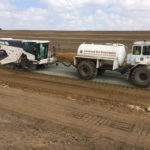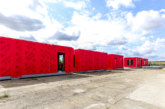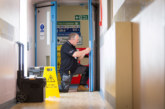Councils need to examine the potential of soil stabilisation to help the Government meet its target of building nearly 6,000 new homes on brownfield land by 2024, believes Britpave, the infrastructure group.
Michael Gove, the Levelling UP and Housing Secretary, has announced that 53 local councils have been allocated £58m from the Brownfield Land Release Fund to help them clear brownfield land to allow for the building of 5,600 new homes within three years. Making the announcement, Micheal Gove stated: “Making the most of previously developed land is a government priority and it will help protect our cherished countryside and green spaces.”
The announcement follows Prime Minister Boris Johnson’s declaration at the recent Conservative Party conference that new homes should not be built on “green fields” and vowed to protect the countryside from being “desecrated by ugly new homes”.
The new focus will be on boosting construction on brownfield sites, which have been previously developed and are less controversial locations for house building. The shift in strategy is designed to reassure Conservative MPs in the party’s “blue wall” heartlands in the South East, who fear a major backlash from voters alarmed at the prospect of swathes of new development on greenfield sites.
Councils wanting to realise the potential brownfield sites should examine the capability of soil stabilisation to help bring those sites back into productive use believes Al McDermid Chair of the Britpave Soil Stabilisation Task Group. Al said: “Soil stabilisation can sustainably and cost-effectively improve the soil condition of sites previously thought unsuitable for development or can be used as part of remediation strategies to successfully address past industrial brownfield sites. These sites then offer a real alternative to greenfield sites.”
Using cementitious binding materials such as lime, cement, fly ash and ground granulated blast furnace slag (GGBS), soil stabilisation can treat contaminants within the soils, on site, to provide a material that is safe to use in construction; with a greatly reduced risk of leachate contamination to the wider environment.
“The traditional approach to re-use brownfield land is to simply dig up the problem soil and dump it elsewhere. This is not an environmentally sustainable or cost-effective approach,” explained Al. “Dealing with the problem on site minimises the cost and nuisance of lorry movements, negates the need to pay landfill taxes and removes the need to import virgin aggregate.”
However, Al warned: “Soil stabilisation involves a lot more than a tractor simply churning up the ground and scattering over some binder. Soil types and possible contaminants need to be assessed and tested so that the correct binder can be administered. Handling binders correctly requires a proper health and safety protocol. It also requires the use of specially developed plant to ensure that the mixing and placement of soil and binder is efficiently undertaken. As with all things, the best results are achieved when it is carried out by experienced best practice contractors.”









